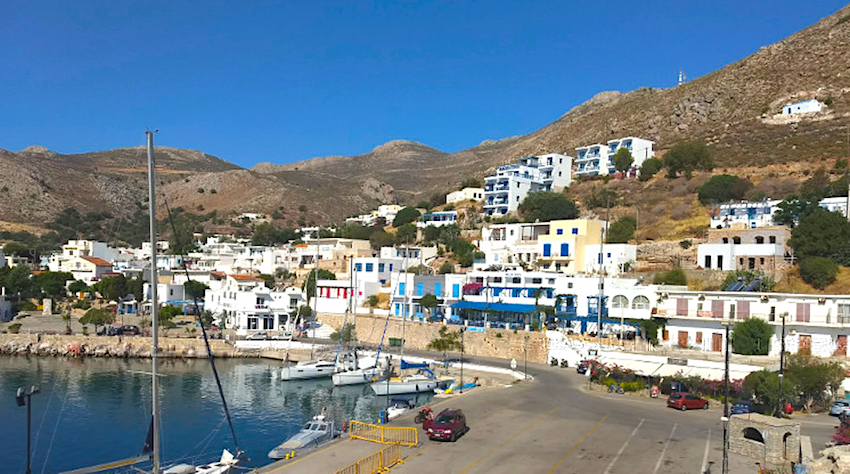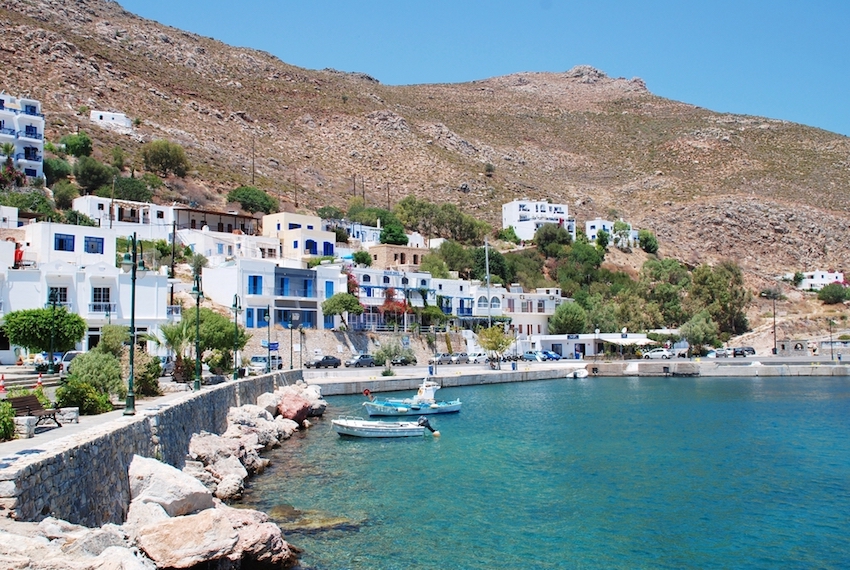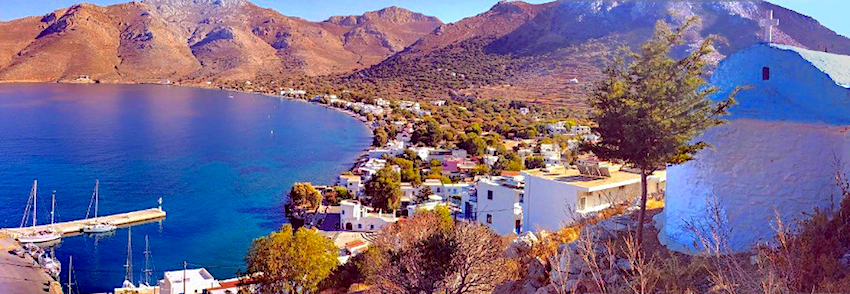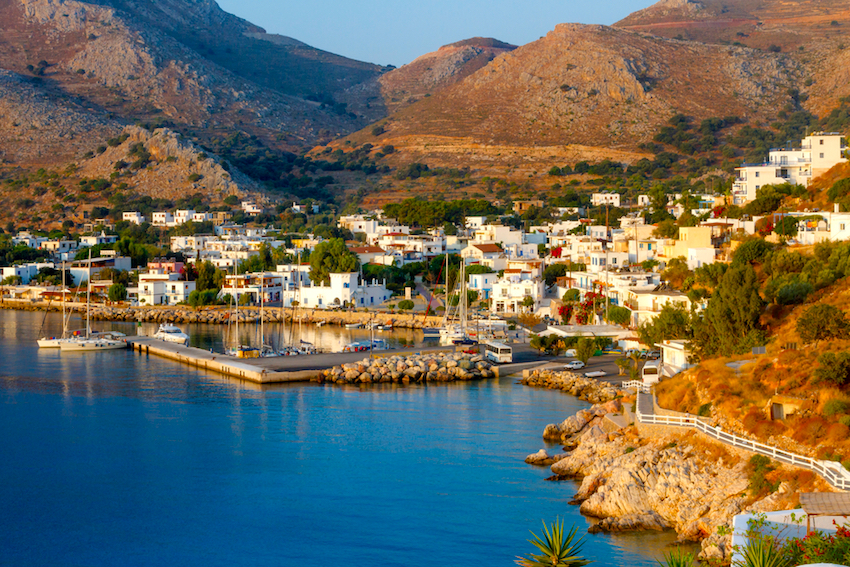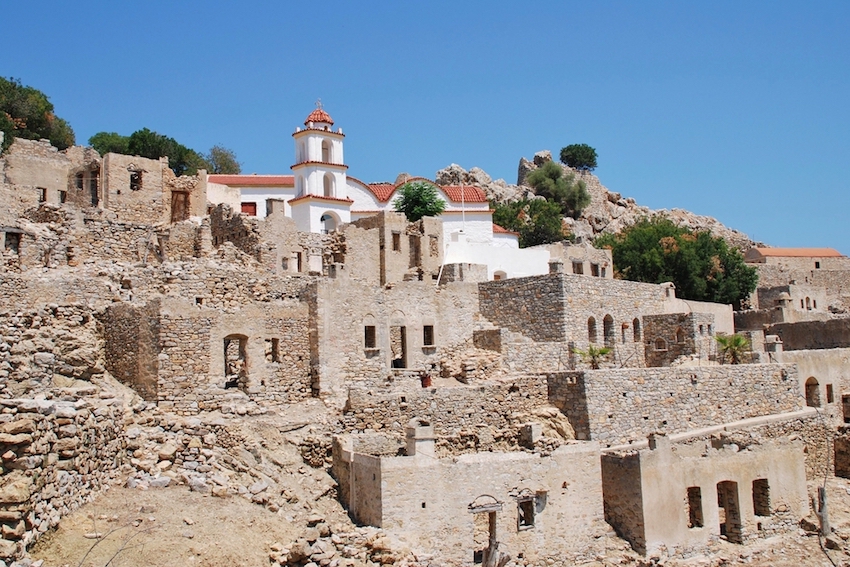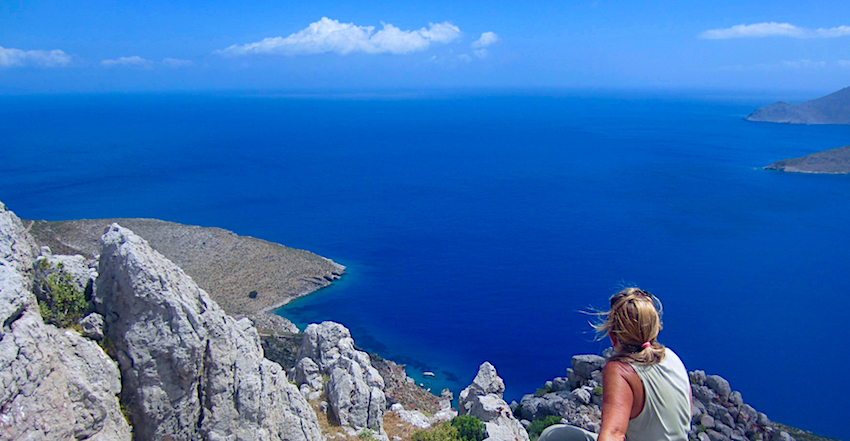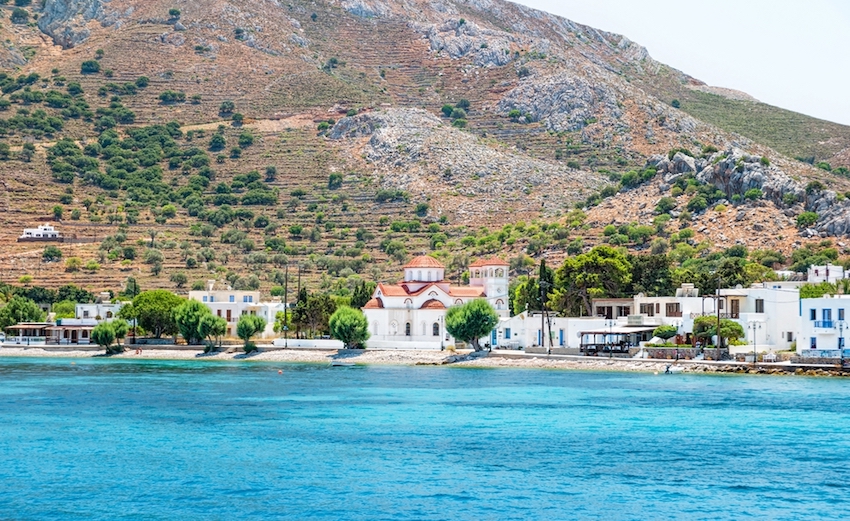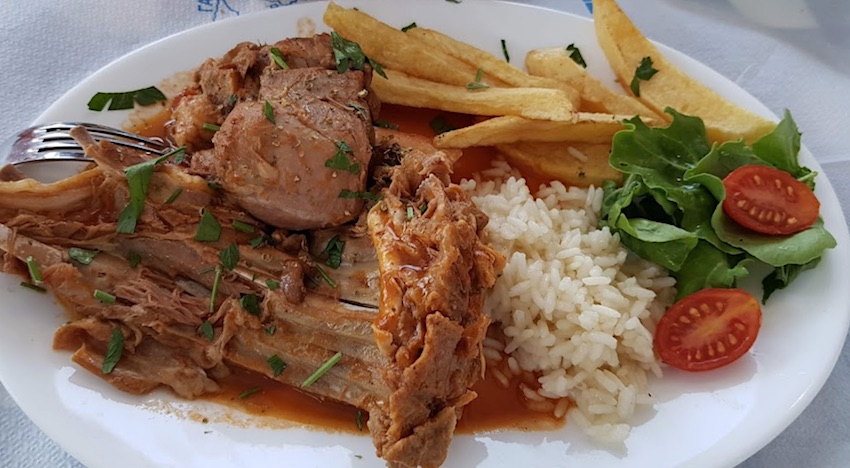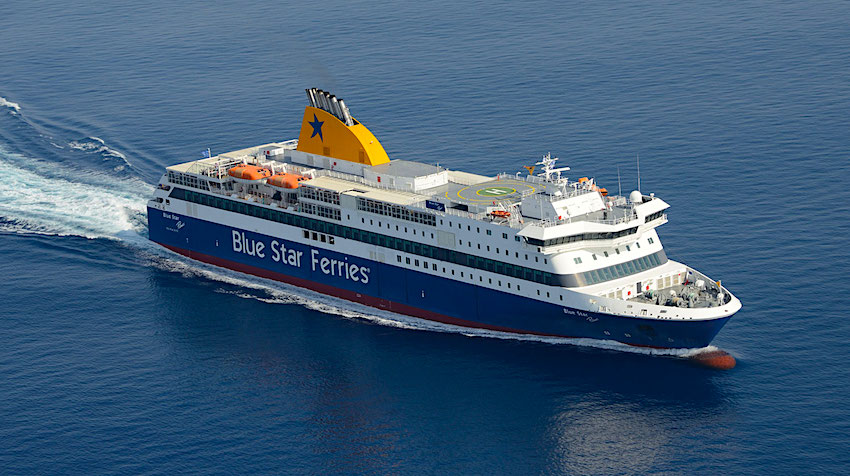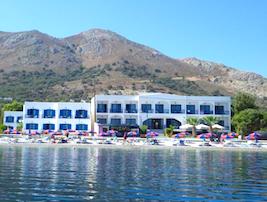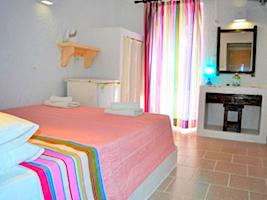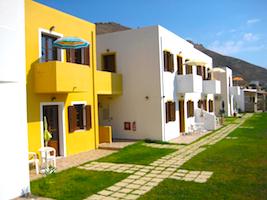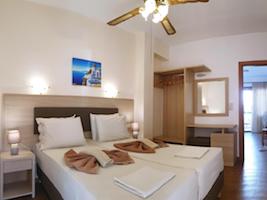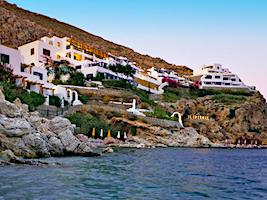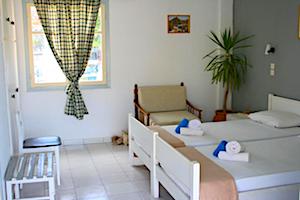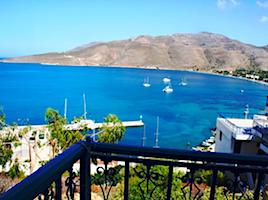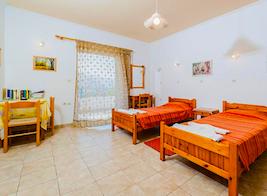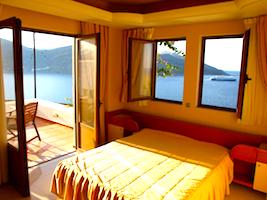
Tilos
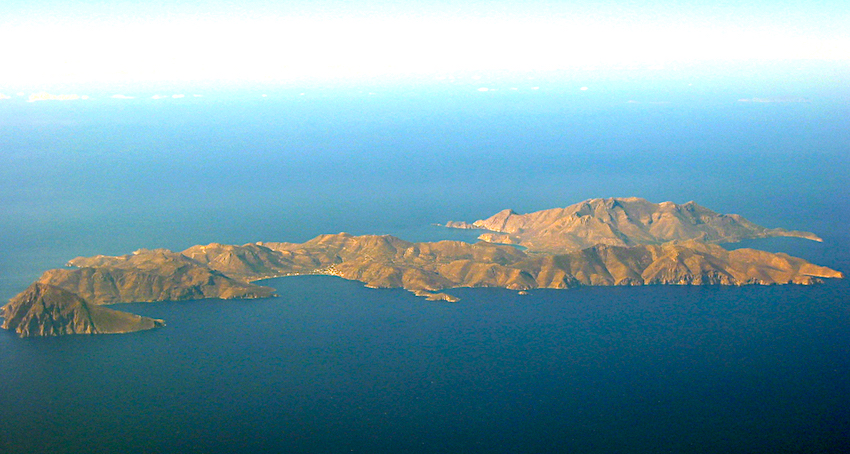
By Chrischerf - Own work, CC BY-SA 3.0, https://commons.wikimedia.org/w/index.php?curid=14526087
TILOS
|
|||||||||||||||
|
|
|||||||||||||||
|
Your first view of Tilos will likely be from the deck of a Blue Star, Saos or Dodekanisos ferry as you make your way up from the island of Rhodes – and its international airport - 30 kilometres to the southeast. The island rises sharply from the sea, and then yields to a broad bay with a modest string of buildings peering from tamarisk trees on the shore. A denser cluster of buildings and bougainvillea covers the western-most hills of the harbour, marking the epicentre of the village. At the water's edge you will see the ferry slip, and a good proportion of the island population pressed against it, waiting for the ferry to arrive. |
|||||||||||||||
|
Your island baptism begins with the joy and vibrancy that envelops you the moment the ferry docks, as the people waiting say goodbye or greet loved ones, as shipments are quickly unloaded and dispatched, as cars and scooters and army trucks and foot passengers joust for space in the glorious confusion. Disentangling yourself from the fray will not take long as most people come and go from the ferry on foot, their destinations but a short walk away. |
|||||||||||||||
|
|
|||||||||||||||
|
A few steps past the ferry slip and the small fleet of yachts pulled up quayside will have you on the path to the main town square; a small fig-bedecked plaza bordered by a few shops and tavernas. Expect to see a few Tilly-hatted hikers holding court near the periptero, children playing on swings nearby, people haggling with the fish pedlar who is selling his catch from the tailgate of his antediluvian Toyota, and Giorgios ceremoniously carrying a tray of kafes to regulars outside his kafeneio. Tilos has just wrapped its arms around you, and the adventure, and love affair, has begun. |
|||||||||||||||
|
|
|||||||||||||||
The Island and its HistoryEmbracing Tilos right back is not hard to do. It's a small island - 14 kms long and 5 kms wide at its widest point - so taking in every corner, via road or ancient path, can be easily achieved in a week. The terrain is arid and mountainous, much like its mother-ship, Asia Minor, which it parted from 6,000,000 years ago. Remains of elephants believed to have been trapped on the island after the fissure from the mainland have been found in caves on the island, their dwarf-sized skeletons (120-1.60 metres tall) suggesting they had adopted to their truncated habitat by shrinking in size. Ties with the neighbouring volcanic island of Nisyros are also clear by the lava deposits that blanket the central ravine of island and the lower lying plains – remnants of an eruption around 8,000 BC. A cordillera of limestone mountains forms the austere backbone of the island broken by occasional copses of olive trees nurtured by the island's network of underground springs. It is believed that the island gets its name from Telos, the mythological youngest son of Alia and Helios (the sun god). When Alia was ill, Telos came to this spring-fed island to collect herbs and ointments to heal his mother. Treatment successful, Telos returned to the island, built a sanctuary and assumed the role of 'hierapolos' (holy servant) in honour of his mother. This role became a special office of all priests serving on Tilos. The island's name was threatened at times by Turkish or Italian alternatives (Ilyaki and Piscopi) but to the Greeks, Tilos has always been Tilos. Historical records make scant mention of Tilos; it is often undifferentiated from its political allies – Rhodes and Kos. We do know through the Greek historian, Herodotus, that during the Classical period (5th century B.C.), the poetess Erinna turns up on Tilos. Few of her poems survive, (though reputedly, many were paeans to the natural beauty of Tilos) but she was regarded as highly as her contemporary Sappho, on island of Lesvos, for her lyric poetry, Jumping ahead, we learn that after the fall of Rhodes in 42 B.C. to the Romans, Christianity gradually begins to supercede traditional beliefs. Into that changing climate, the ‘defenders of the faith’ – the Knights Hospitaller – arrive in 1309. With the intent to govern and protect citizens from Ottoman invasions, the Knights Hospitaller become a strong presence on Tilos and all the Dodecanese Islands, sheltering islanders and successfully withstanding Ottoman invasions for the next 200 years. Seven castles were built during that time on Tilos, the ruins of five which still remain (Aghriosykia, Stavros Lambros, Mikro Choria, Messeria and Paleokastro). In 1522, after the long seige of Rhodes by Suleiman the Magnificent and his 400 ships and 100,00 men, the Knights surrendered their claim to the Eastern Aegean. Things didn't quiet down after the Turkish conquest. The Ottomans were soon followed by Venetian pirates in the 17th century, and Greek revolutionaries in the 19th, ostensibly targeting Turkish occupiers with their raiding and looting. Domination and administration by the Italians after the Italo-Turkish war in 1912 came to an end in 1943 when the Germans commandeered control during World War II. In 1948, Tilos, and the Dodecanese islands, found their way back again into the Hellenic fraternity. |
|||||||||||||||
|
|
|||||||||||||||
Tilos TodayFreedom at last from foreign occupation was overshadowed by internal political strife in Greece, and Tilos was not spared the hardships of the civil war (1946-1949) nor life under the military junta (1967-1974). Agricultural traditions on the island - husbanding goats (whose bloodline is considered one of the purest in Greece), and harvesting fish and seafood, wheat, potatoes, and olives - were staples of the islanders' lives and sustained them during these impoverished times. After the dissolution of the junta government, and gradual shifting of economic foci, the villages of Mikro Chorio and Ghera were dismantled and the harbour possibilities of the seaside village of Livadia seized. The shift from villages in the lee-side shadow of mountains to ferry-friendly docking points began to pay economic dividends for the islanders. Visitors were now able to pull up dockside, and word soon gets out about the beauty of the land and generosity of the people. Island hospitality becomes a currency in the emerging tourism-driven economy of Greece. Joining the European Union in 1981 also supported Greece and Tilos's efforts to modernize and develop its tourist infrastructure. Modern life also saw Tilos, under the leadership of its forward-looking mayor, Tassos Aliferos, institute a number of progressively-minded changes. A strong environmentalist, Aliferos persuaded the island to ban hunting in 1993 in order to protect its flora and fauna, including a number of endangered bird species such as Bonelli's eagle and the Eleonora falcon. In 2003, the island's bio-diversity (which includes 378 botanical varieties and 162 resident and migratory wild bird species), prompted the formation of the Tilos Park Association which today ensures the protection of the island's diverse ecosystems. In 2008, the first gay marriages in Greece were performed in Tilos, seven years before same-sex marriages were legalized in the rest of the country. Building on Tilos's reputation as a 'green island', and committed to the championing of human rights, current mayor Maria Kamma-Aliferos has implemented further visionary ideas. Tilos is becoming one of the first Greek islands to explore the use of renewable energy – solar and wind – thereby eliminating the need to import power from distant sources (such as, in the case of Tilos, an underground cable from Kos). A photo-voltaic park and a windmill have been installed to form the hybrid micro-grid necessary to generate and store energy. You can expect to see a variety of innovative steps towards both environmental and people-friendly spaces on Tilos. Much of the town's lighting is solar powered, the island bus is electric, there is an EV charging station in Livadia and a new 'just-go-zero- waste initiative that will bring you up to speed on just what can be recycled! A sea elevator for bathers with mobility issues has recently been installed between sun-beds on the town beach...right next to Sweet Corner! The island's inclusiveness has also been extended to refugees; a new program, which strives to integrate refugees into the community, with housing, employment and schooling for the children, is providing a welcome structure of 'home' to a few families with young children. |
|||||||||||||||
|
|
|||||||||||||||
Exploring TilosAn unheralded charm of the Dodecanese, Tilos's stewardship of habitat and history makes it a delight to explore. Relatively unpopulated and undeveloped (about 500 year-round residents) means that roads, harbours, and trails are blissfully traffic-free and visitor-friendly. Ground central for your explorations will likely be from the transportation hub of the island – the port of Livadia. Livadia comes equipped with the usual smorgasbord of pensions, apart-hotels, beaches with sun-beds, restaurants, bakeries and mini-markets but the infrastructure is small and the scale is slight and inconspicuous, with white-washed hotels merging with local residences in a harmonious gaggle of harbour-side buildings. A stone-lain, lamp-lit esplanade knits the sprawling harbour-side together and one of the most beautiful Byzantine churches lies alongside it, as does a silversmith's shop, an information office, a homegrown workout space – the Tilos Street Workout - a crenellated police station (thanks to the Italians!), and the ferry ticket hub - Stefanakis Travel. Post-'siesta', expect to be swept up in the energy of the centre of the village – the square – and the narrow streets that radiate from it. With the square bathed in a golden glow, taverna owners and shopkeepers enfold you into the glorious chatter and warmth that is a Greek village at sunset. It is not surprising that many of the visitors that you talk with are coming back for the third, the seventh, and twenty-third time! In the summer, it's families charmed by the simplicity and safety of town beach life, and in the shoulder season, the scaled-down size, slower pace, and opportunities for 'soft adventure' on the island appeal to the seasoned traveler. At those times of the year, you may feel that the entire island is like being ushered into the lobby of “The Marigold Hotel” and instead of being issued a pool towel, you are issued a set of hiking poles! While there are a few opportunities for guided exploration of the island, the island is easily explored on one's own. Renting a car, scooter or buggy is a good way to take in road-accessed regions of the island. One road twists along island's southeast spine to the glorious panoramic site of...wait for it....the island's landfill, the other to the capital of the island – Megalo Chorio – and onwards, past the free-camping beach of Eristos and small port of Agios Antonios (and its beach rocks with human skeletons that date from the 5th century B.C.). Then, via a spectacularly dramatic ribbon of road high above the Aegean, you will reach the impossibly perched, perfectly preserved Byzantine monastery – Agios Pandeleimon. A remarkable structure, apparently disguised as a fortified-looking castle to deter Barbarossa and other pirates in their day, it is now home to numerous cats, a visiting priest, and an annual name-day shindig on July 27. |
|||||||||||||||
|
|
|||||||||||||||
|
The deserted village of Mikro Horio, like on many of the islands, was the historic center during days of raids and invasions, and was eventually abandoned (actually, not until the 1960's) as people could see the practicalities of living by the sea. A few buildings have been maintained, or restored and are still used today, like the Church of Panagia Theotokissa and....a disco bar during the summer, open from 11 pm - dawn for music and dancing. |
|||||||||||||||
|
|
|||||||||||||||
TrailsThe best way to take in this little piece of heaven is to walk it. Be prepared to be incurably smitten by the island's trails. They will all be on dirt tracks high above the blue-green layers of the Aegean with hints of white sails and offshore islands beyond. They will all have interesting destinations in mind – either to a secluded cove, a cliff side castle, or the alonia (threshing circles) aside an abandoned village. Given that there are 25 beaches accessible by foot only, five Knights of Hospitallar castles, 300 chapels, two monasteries and three abandoned settlements within the 14X5 kilometre dimensions of the island, the likelihood of bumping into one of these is somewhat inevitable. You will set out with a bottle of water (easily refilled at the natural springs you will stumble upon en-route), and your Greek repast of bread, olives and cheese, and let the words of writer Patrick Leigh Fermor nudge you still further into the hills: “All of Greece is absorbing and rewarding, There is hardly a rock or stream without a battle or myth or a peasant anecdote or a superstition, and talk and incident, nearly all of it odd or memorable, thicken round the traveler's path at every step.” The best-marked and arguably most scenic trails are the two that peel from Livadia – one east to the abandoned village of Gera (and Nero Beach), and the other west to the meadow and beach of Lethra, once the seaside adjunct to Mikro Chorio. Others, including the paths to the castles, the beaches of Skafi, Stavros, Tholos, Agios Serghios, the old settlement of Pano Meri, the Italian observatory, and the trails that wrap around the tallest mountain on the island, Profitas Ilias, are best done with Jim Osborne's superb and detailed guidebook,“Exploring Tilos – a Walker's Guide to the Island” in hand. And for those keen to identify the local flora and fauna, Pierre Seba and Pascale Servais's “Tilo Botanica” is the authoritative text on the subject, and will help you distinguish between a thorny burnett and a Mediterranean gorse, a crown of thorns and a hedgehog (just kidding). Trail maps and guides are available at shops in either Livadia or Megalo Horio. As a Canadian and keen hill-walker, I have been pulled back to Tilos year after year and now own a small traditional stone house at the top of the main village. In contrast to the vast distances in my home country, I love having a home snug in the warp and weft of a tightly knit village where you realize that your home's walls are only figurative as there is always the sense that everyone's lives are inherently shared: you wake to the same rooster, the same riotous ringing of church bells, the same trucks braking as they reach the bottom of the hill, the same children excitedly preparing for school. Within moments, after tumbling down the stairs, you are in the town square, breathing in the collegiality of village life and exhaling with the delight of knowing that this kind of quiet goodness is what awaits you every time you come home to Greece. You've been warned – if it's not the thyme-scented hills that will get you on Tilos, it will be the vibrancy of the village square on a summer's eve! |
|||||||||||||||
|
|
|||||||||||||||
Beaches on TilosTilos is blessed with a bevy of beaches, many of them secluded and remote, so getting to them is half the fun! A good place to start is 'the town beach' (Livadia), a wide smile of small-scale hotels and cafes, pebbled beach shaded by tamarisk trees, and remarkably crystal-clear waters. A swimmer's delight, and sunbeds are available for hotel guests and cafe patrons. Further afield, but also easily accessed, are beaches in the centre of the island – wave-swept Eristos, with its camping and clothing-optional section on the east side of the beach, and Plaka, also with its clothing-optional area, and, wait for it..... it's very own muster of peacocks! Skafi Beach, via a bumpy dual-track road, is also nearby. |
|||||||||||||||
|
|
|||||||||||||||
|
You'll need to strap on your boots for the other beaches on Tilos. On either side of Livadia, via two spectacularly cliff-hugging, sea-side trails, are the nestled-in-quiet beaches of Lethra and Nero – one a 50 minute walk, the other 90 minutes. If you are still more adventurous, three beaches on the south side of the island await you: Agios Sergio, Tholos and Stavros. Be prepared for more rugged conditions on these trails, and the need to be equipped with sturdy footwear, own water and food, and exquisite communion with sea, sand, sky and occasional bleating goat when you get there! |
|||||||||||||||
|
|
|||||||||||||||
Eating Out in TilosYou will really be spoiled for choice when it comes to deciding where to have that morning coffee, afternoon drink or evening meal. Whatever you choose to do, make sure to ask for either the local calamari, octopus or goat (cooked in a variety of ways) and the traditional Dodecanese 'raki' – souma – all of them specialties of the island. Rementzo is your go-to place as you wait for the ferry (with generous plates of mezes offered with your drink), and nearby Blue Sky and Gorgona(photo) take in sweeping harbour views. Further along on the promenade will bring you to Kritikos, Filoxenia, Nautilus, Dreams, and Armenon, not forgetting the cafe/bars in between – Bozi, Mikro Cafe, Pezodromos and Sweet Corner (known for its delicious crepes). For a bird's eye view of the town, try Faros on the far side of the harbour. For 'hide-away dining' (those nooks a little back from the waterfront), there's Michalis Taverna, set in a beautiful courtyard, The Mediterranean Grill, which offers a wide range of Greek dishes that Greek-American chef, Tony, serves up with a twist, Trata, with its fish-of-the-day specialties, and the popular Kyriakos Grill, which not only has the best gyros in the region, but great vegetarian specialties made to order, like their house briam which rivals the gigantes and zucchini fritters that Omonia in the square is famous for. To wrap up your evening, linger in the square at Petrino's Bar (which often plays host to local and visiting music or dance groups), or if it's the music of Neil Young or Mark Knopfler you're hankering for, Martha is spinning those classic rock discs at Ino, a delightful cocktail bar right by the sea. Over in Megalo Horio, there's To Kastro and Paleo Meraki, both with fabulous views across Eristos Valley, where you'll also find Eristos Beach Hotel and vine-bedecked En-Plo. Venture even further to Delfini or El Pida in Agios Antonis where you can sit with toes in water swathed in the setting sun, and contemplate Zorba's words: “how simple a thing is happiness – a glass of wine, the sound of the sea.....” Morning coffee in the square is a must, particularly if you need to catch up on island news, gossip, and that glorious time to watch the world go by on a big fat Greek sunny morning! Bagia, George's, and The Coffee Nest will help you with that, and for some take-home pastry, pop along to the bakery nearby for fresh spanokopita, savoury or sweet pies and a range of breads and biscuits. And make sure you snag a jar of the famous Tilos thyme honey (recently awarded a gold medal in the London International Honey Awards!) in one of the many shops on the island. |
|||||||||||||||
|
|
|||||||||||||||
Getting To and Around TilosTilos is well connected by ferry to the island of Rhodes and neighbouring Dodecanese islands of Chalki, Symi, Nisyros, Kos and Kalymnos. The Blue Star, Saos Line, and catamaran Dodecanisos all sail twice a week to and from Rhodes throughout the year, joined by the Panagia Evangelistria in the summer, departing from Kamiros Skala on Rhodes. Athens is fifteen hours away by ferry on The Blue Star, so cabins are advisable if you choose this travel option! You can find ferry schedules on Ferryhopper.com On the island, car and scooter rentals are available at Stefanakis Travel, Drive Rent-A-Car and Iris Rent-A-Car. Iris also rents buggies. The island public bus shuttles people from one side of the island to the other; expect departures to Megalo Horio, Eristos Beach, and Agios Antonis from Livadia every hour in the summer. Also in the summer, every Sunday there is a special service to the Monastery Agios Panteleimon at 11:00 a.m. from Livadia. Guided tours are offered by Blue Sky Travel Agency, including boat cruises to Nisyros or Chalki, or excursions by mini-bus to the Elephant Museum or soon-to open Archeological Museum in Megalo Horio, or to the Monastery Agios Panteleimon (+30 22460 44 294). Tilos Taxi (+30698 943 3392) is now an option, too. |
|||||||||||||||
|
Written by J. Kathleen Thompson, a freelance writer and incurable enthusiast for adventure, music, the extraordinary in the everyday, and liberal amounts of Greek sunshine and yogurt. When not on a bike or boat in the Mediterranean, she calls Canada home. Visit her blog at justgojo.com. Thank you to Ann-Marie Lardopoulou Christensen, and Carol Kelly who also contributed to this article. |
|||||||||||||||
Hotels and other Accommodation in Tilos |
|||||||||||||||
|
|||||||||||||||
 Use Ferryhopper to find all direct and indirect ferry routes for the islands of Greece, Spain, Italy &
Turkey, compare ferry companies & prices, and book cheap ferry tickets with no hidden fees in one go!
Use Ferryhopper to find all direct and indirect ferry routes for the islands of Greece, Spain, Italy &
Turkey, compare ferry companies & prices, and book cheap ferry tickets with no hidden fees in one go!
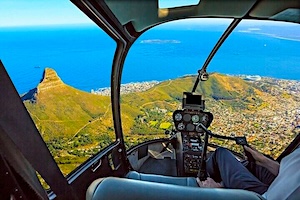 Travel to the Islands by Helicopter!
Travel to the Islands by Helicopter!
Join Matt Barrett's Greece Travel Guides Group on Facebook for comments, photos and other fun stuff. If you enjoy this website please share it with your friends on Facebook. If you are appreciative of all the free information you get on my websites you can send a donation through Paypal or you can use Venmo
